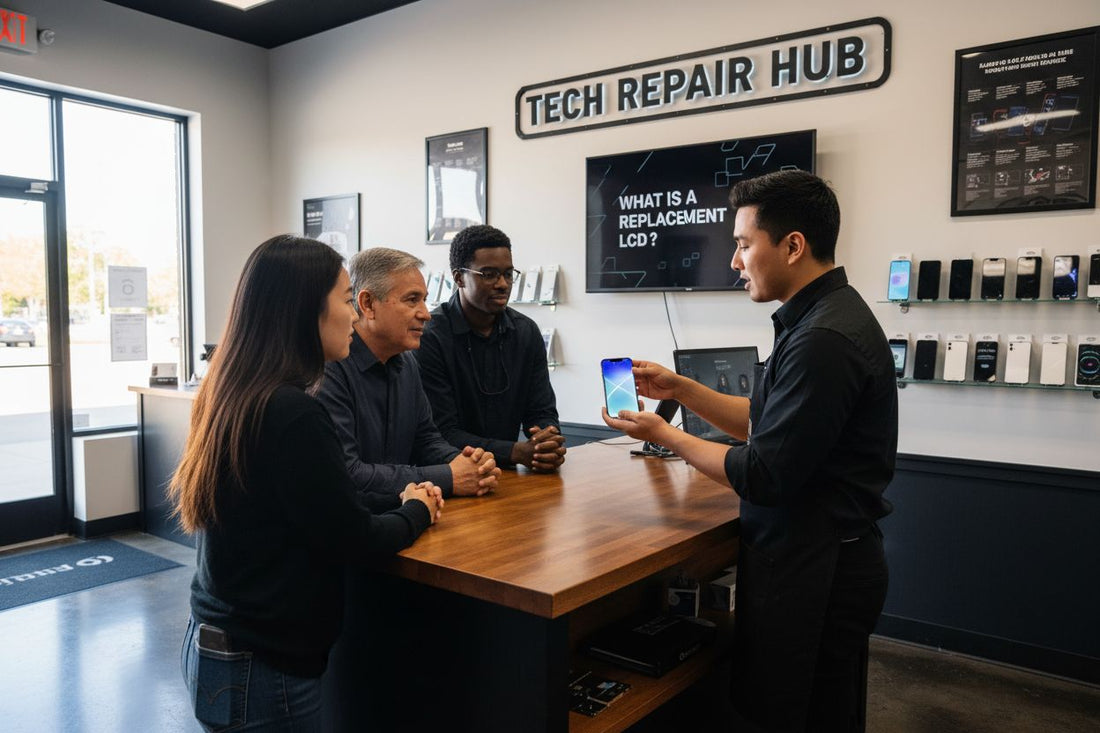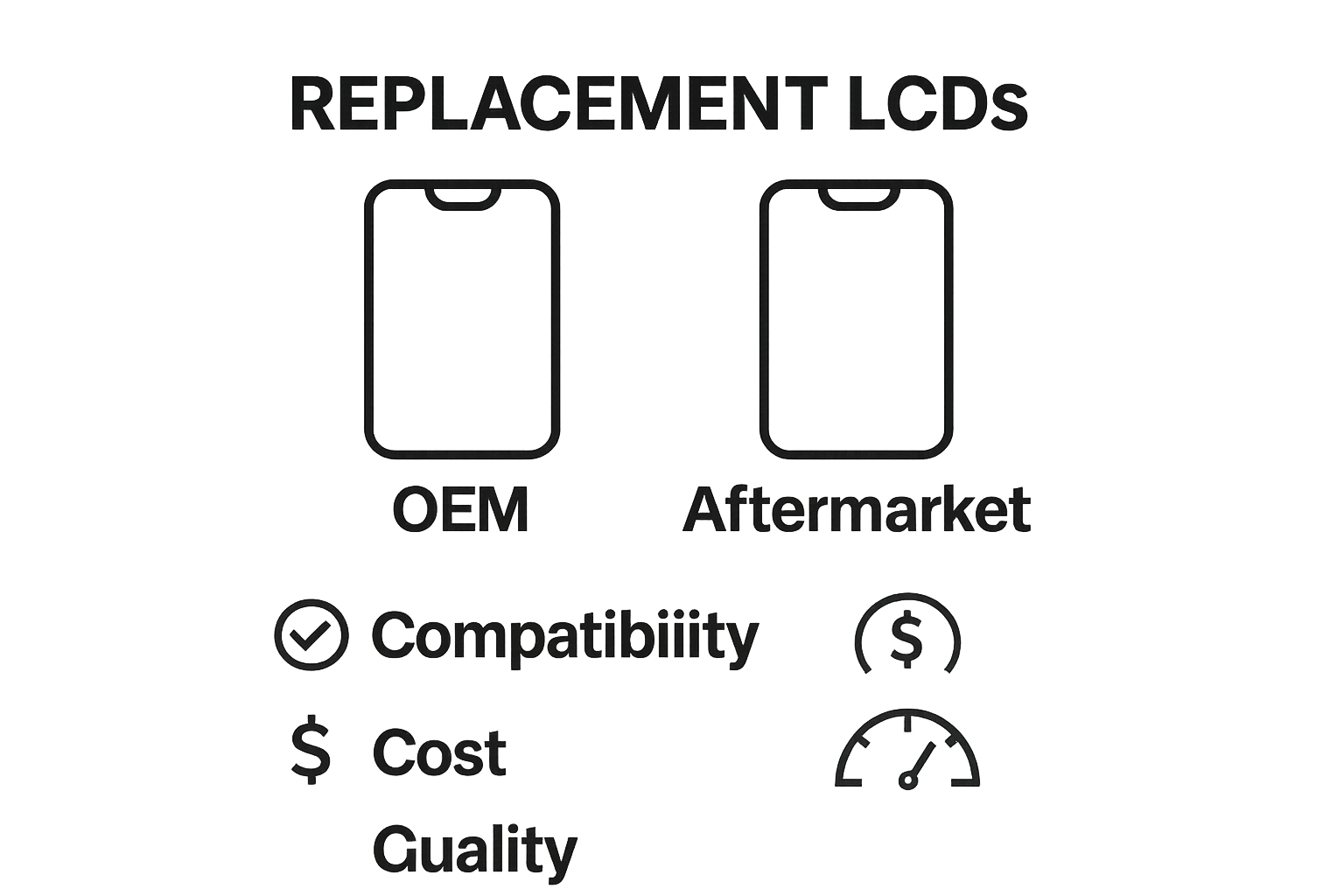
What is a Replacement LCD? Understanding Key Concepts
Share
Smartphone LCD screens have become the silent powerhouses behind every vivid selfie and streamed film. Most people are shocked to learn that a typical modern smartphone LCD can display millions of colours with extraordinary precision. Yet, the true marvel is not just in their image quality. The biggest surprise is how these replacement LCDs are quietly leading the push for sustainability, making your next repair far more eco-friendly than you might expect.
Table of Contents
- Understanding The Function Of Lcds In Smartphones
- Importance Of Replacement Lcds In Device Repairs
- Key Features To Look For In A Replacement Lcd
- How Replacement Lcds Contribute To Sustainability
- Differences Between Oem And Aftermarket Replacement Lcds
Quick Summary
| Takeaway | Explanation |
|---|---|
| LCDs convert electrical signals to visuals | Smartphone LCDs use liquid crystal technology to display images, allowing interaction with devices through vibrant screens. |
| Replacement LCDs extend device life | Replacing damaged LCDs is cost-effective and helps reduce electronic waste instead of buying new devices. |
| Choose quality and compatibility in replacements | Ensure the replacement LCD matches the original specifications for resolution, touch sensitivity, and durability to maintain device function. |
| OEM screens guarantee performance and compatibility | Original Equipment Manufacturer screens are made to match the precise specifications of your device, ensuring optimal function at a higher cost. |
| Aftermarket options can vary widely in quality | While often cheaper, aftermarket LCDs may have inconsistent quality; careful evaluation is necessary to ensure satisfactory performance. |
Understanding the Function of LCDs in Smartphones
Smartphone liquid crystal displays (LCDs) represent a sophisticated technological marvel that transforms electrical signals into visual experiences. These intricate screens are fundamental components that enable users to interact with mobile devices through vibrant, responsive displays.
How LCD Technology Works
At its core, an LCD operates through a complex mechanism of liquid crystal molecules sandwiched between two polarised glass panels. According to Britannica, these molecules can be electrically manipulated to control light transmission, creating the images we see on smartphone screens.
The process involves several critical stages:
- Electrical signals activate specific liquid crystal molecules
- These molecules adjust their alignment based on the voltage applied
- Light passes through or gets blocked depending on molecular orientation
- Colour filters transform these light patterns into recognisable images
Key Components of Smartphone LCDs
Smartphone LCD screens consist of multiple intricate layers working harmoniously. These include:
- Backlight layer: Provides illumination for the entire display
- Polarising filters: Control light wave orientation
- Liquid crystal layer: Manages light transmission
- Colour filter layer: Generates colour variations
- Glass substrate panels: Provide structural support
Performance and Display Quality
The quality of an LCD depends on several technical parameters. Resolution, colour accuracy, and response time determine how crisp and responsive a smartphone screen appears. Modern smartphone LCDs can display millions of colours with remarkable precision, offering users immersive visual experiences across different lighting conditions.
Understanding replacement LCDs requires recognising these complex technological interactions that transform electrical signals into the vibrant displays we interact with daily.
Importance of Replacement LCDs in Device Repairs
Replacement LCDs play a pivotal role in smartphone repair ecosystems, offering an economical and sustainable solution for addressing screen damage. These components enable device owners to restore functionality without purchasing entirely new devices, representing a critical intervention in mobile technology maintenance.
Economic and Environmental Significance
Research from environmental studies highlights that screen replacements significantly reduce electronic waste by extending device lifecycles. Replacing a damaged LCD allows users to:
- Avoid costly full device replacement
- Restore smartphone functionality
- Reduce electronic waste
- Maintain personal data and device configurations
Technical Considerations for LCD Replacement
Quality replacement LCDs must meet stringent technical specifications to ensure optimal performance. Professional repair technicians assess several critical factors when selecting appropriate screen replacements:
- Screen compatibility: Exact model and generation matching
- Display resolution: Maintaining original visual quality
- Touch sensitivity: Preserving precise user interaction
- Colour reproduction: Ensuring accurate colour representation
- Durability: Matching original manufacturer standards
Cost-Effective Repair Strategy
Replacement LCDs represent a strategic approach to device maintenance. By targeting specific damaged components rather than entire devices, users can save significant financial resources.
Professional repair services can often restore smartphone functionality at a fraction of the cost of purchasing new devices, making LCD replacement an attractive option for budget-conscious consumers.
Understanding the nuanced role of replacement LCDs transforms how we approach device repair, positioning these components as essential tools in sustainable technology management.
Key Features to Look for in a Replacement LCD
Selecting an appropriate replacement LCD requires careful evaluation of multiple critical parameters. Understanding these key features ensures smartphone owners and repair professionals make informed decisions that maintain device performance and visual quality.
Screen Quality and Specifications
According to mobile technology research, replacement LCDs must precisely match original device specifications. Critical quality indicators include:
- Resolution: Exact pixel count matching original screen
- Colour accuracy: Consistent colour reproduction
- Brightness levels: Comparable illumination performance
- Contrast ratio: Maintaining visual depth and definition
Compatibility and Technical Considerations
Technical compatibility represents a fundamental requirement when selecting replacement LCDs. Repair professionals must verify:
- Precise smartphone model matching
- Connector type and pin configuration
- Touch sensitivity calibration
- Structural dimensions and mounting points
- Electrical interface specifications
Durability and Manufacturer Quality
Quality replacement LCDs must demonstrate robust construction and reliable performance. Key durability factors include:
- Materials: High-grade glass and polarising filters
- Manufacturing standards: Adherence to industry quality control
Ultimately, choosing a replacement LCD demands meticulous attention to technical details, ensuring seamless device functionality and user experience.
The following table presents the main technical features and considerations to evaluate when choosing a replacement LCD, helping to ensure optimal device function and longevity.
| Consideration | Explanation |
|---|---|
| Model Compatibility | Must precisely match the smartphone model and generation |
| Resolution | Maintain the original pixel count for crisp visuals |
| Colour Accuracy | Ensure faithful colour reproduction |
| Touch Sensitivity | Provide responsive and accurate touch interaction |
| Brightness Levels | Match original illumination for visibility |
| Durability | High-quality materials to withstand regular use |
| Connector & Dimensions | Match original connectors and structural design |
 Explore our comprehensive parts selection for professional-grade smartphone screen replacements that meet exacting performance standards.
Explore our comprehensive parts selection for professional-grade smartphone screen replacements that meet exacting performance standards.
How Replacement LCDs Contribute to Sustainability
Replacement LCD technologies play a pivotal role in promoting environmental sustainability within the electronic device ecosystem. By extending the lifecycle of smartphones and reducing electronic waste, these components represent a critical intervention in responsible technology consumption.
Electronic Waste Reduction Strategies
Research from environmental sustainability studies demonstrates that LCD replacements significantly mitigate the environmental impact of electronic waste. By enabling device repair instead of complete replacement, users can:
- Reduce raw material consumption
- Minimise carbon emissions associated with manufacturing
- Prevent toxic electronic components from entering landfills
- Extend device usability and functional lifespan
Economic and Environmental Benefits
Replacement LCDs offer a multifaceted approach to sustainable technology management. The economic and environmental advantages include:
- Lower resource extraction: Reducing demand for new device production
- Energy conservation: Minimising manufacturing energy requirements
- Circular economy support: Promoting repair and reuse practices
- Cost savings: Providing affordable device restoration options
Technological Innovation and Sustainability
Modern replacement LCD technologies are increasingly designed with sustainability principles in mind. Manufacturers are developing screens using:
- Recycled materials
- More energy-efficient production processes
- Modular design for easier repair and component replacement
- Environmentally friendly manufacturing techniques
Ultimately, replacement LCDs represent more than a technical solution – they embody a progressive approach to responsible technology consumption and environmental stewardship.
Differences Between OEM and Aftermarket Replacement LCDs
Understanding the nuanced differences between Original Equipment Manufacturer (OEM) and aftermarket replacement LCDs is crucial for making informed decisions about smartphone screen repairs. These two categories represent distinct approaches to display component replacement, each with unique characteristics and implications.

Manufacturing Origin and Quality Standards
Research from consumer electronics studies reveals significant variations in manufacturing processes between OEM and aftermarket LCD screens. OEM screens are:
- Produced directly by the original device manufacturer
- Manufactured using identical specifications as original screens
- Guaranteed to match exact device model requirements
- Typically more expensive but ensure precise compatibility
Performance and Technical Specifications
Aftermarket replacement LCDs present a more complex evaluation landscape. Key differentiating factors include:
- Manufacturing precision: Varying levels of quality control
- Component sourcing: Different material procurement strategies
- Cost considerations: Generally more affordable options
- Performance consistency: Potential variations in display quality
- Warranty coverage: Often limited compared to OEM components
Cost Versus Quality Considerations
The choice between OEM and aftermarket LCDs involves balancing multiple factors:
- Aftermarket screens offer more economical repair solutions
- OEM screens provide guaranteed compatibility and performance
- Professional technicians recommend carefully evaluating individual replacement needs
- Some aftermarket manufacturers produce high-quality, performance-comparable screens
Ultimately, understanding these differences empowers users to make strategic decisions about smartphone screen replacements, considering both technical requirements and budgetary constraints.
To clarify the distinction between OEM and aftermarket replacement LCDs, the following table summarises their key differences in manufacturing, performance, and cost.
| Feature | OEM Replacement LCDs | Aftermarket Replacement LCDs |
|---|---|---|
| Manufacturing Source | Original device manufacturer | Third-party manufacturers |
| Compatibility | Matches exact device specifications | May vary, model-specific alignment required |
| Quality Standards | Stringent, identical to original | Variable, depends on manufacturer |
| Performance Consistency | Guaranteed | Can be inconsistent |
| Cost | Generally higher | Typically more affordable |
| Warranty Coverage | Usually comprehensive | Often limited or varies |
| Material Sourcing | Consistent, original-grade materials | Varied sourcing, may differ from OEM |
Restore Your Screen, Revive Your Device with Confidence
If you are facing the frustration of a damaged display or an unresponsive screen, you know how vital a reliable replacement LCD is to restoring your smartphone or tablet. The article highlighted key points such as screen compatibility, genuine component quality, and the importance of extending your device’s life while saving both costs and reducing waste. Many users worry about choosing the correct part or maintaining original performance, and it is easy to feel uncertain given all the technical factors involved.
At Buy2fix, you can quickly find genuine and high-quality replacement LCDs for all major brands, whether you need a solution for iPhone, Samsung, Huawei, Xiaomi, or more. Every replacement screen in our range undergoes rigorous quality checks and matches original specifications for optimal colour, brightness, and touch response. You also gain free UK shipping, a 30-day return policy, and a one-year warranty, offering peace of mind on every purchase. Ready to repair with confidence? Start exploring our trusted parts inventory and let your device shine again at Buy2fix’s homepage now. Do not settle for lower performance or risk your data — choose proven quality and expert support today.
Frequently Asked Questions
What is a replacement LCD?
A replacement LCD is a screen component designed to replace a damaged or malfunctioning liquid crystal display in smartphones, restoring the device’s visual functionality without needing to purchase a new phone.
What factors should I consider when choosing a replacement LCD?
When selecting a replacement LCD, consider compatibility with your device model, display resolution, colour accuracy, touch sensitivity, and durability to ensure optimal performance and user experience.
What is the difference between OEM and aftermarket replacement LCDs?
OEM (Original Equipment Manufacturer) LCDs are made by the original manufacturer of the device and guarantee exact compatibility and quality standards. Aftermarket LCDs, on the other hand, are produced by third parties and can vary in quality, offering more economical but potentially less reliable options.
How do replacement LCDs contribute to environmental sustainability?
Replacement LCDs help reduce electronic waste by extending the lifecycle of devices, lowering raw material consumption, minimising carbon emissions from manufacturing, and promoting a circular economy focused on repair and reuse.
Recommended
- Cell Phone, Tablets & Laptops, Parts & Spares - Buy2Fix – buy2fix
- Front Screen Outer Glass Lens with OCA Optically Clear Adhesive for Xi – buy2fix
- Front Screen Outer Glass Lens with OCA Optically Clear Adhesive for Xi – buy2fix
- Front Screen Outer Glass Lens with OCA Optically Clear Adhesive for Xi – buy2fix
Share
Let customers speak for us
from 2140 reviewsPerfect fit, stylish and practical. The wallet attaches firmly and easily accommodates credit cards drivers licence etc.

Working well

Good fit

Very good quality and good fit for Dyson.

This is a genuine Safety Case Strap for DJI Matrice 4.
It arrived well packed.

Excellent fit and so compact even though it has many card slots and coin space, would definitely recommend

All OK

solved my issue here. Perfect, better than the orginal brand standard remote

Excellent website allowing for identification proper parts, good quality and timely delivery. Recommend.

Super hoesje👍👍👍👍👍

I'm very happy with my order, the quality is very good, I recommend:)

Absolutely amazing really best thing I’ve ever used

Nicely stitched quality leather throughout with an attractive checker-board patterned frontage. Shows no sign of wear or fading after considerable use. Good magnetic closure. The sturdy cover provides good protection without being bulky. I expect many years service from this product

Good 👍🏻 😊


